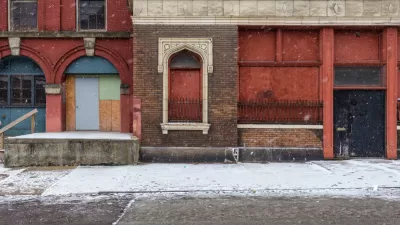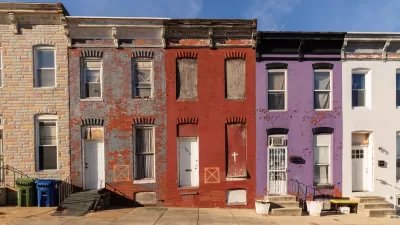As the city of Baltimore grapples with a declining population, it faces obstinate challenges in controlling the problems associated with vacant buildings, including the "vicious cycle" of vacancies causing more vacancies.

"Despite demolition crews working at an unprecedented pace in recent months to tear down Baltimore’s vacant houses, the number of abandoned buildings in the city has barely budged," reports Ian Duncan and Christine Zhang.
"Even as long rows of empty houses are being razed, other homes are going vacant much faster than officials had expected — for reasons they’re at a loss to explain."
In February, the city counted 16,724 vacant buildings in the city. Eight months later, the city counted 16,577. The city had hoped to bring that number below 15,000 by the beginning of 2020, but now it appears that goal is out of reach.
According to city data, the number of vacant buildings in neighborhoods targeted by the city demolition program has dropped, but increasing numbers of vacant buildings in other neighborhoods have kept the overall figures stagnant.
The article includes a description of the "vicious cycle" caused by vacant buildings begetting more vacant buildings, the negative effects of that cycle, and a more granular analysis of neighborhood-level demolitions and vacancies.
FULL STORY: Baltimore is furiously knocking down vacant houses — but barely keeps up as new ones go empty

Trump Administration Could Effectively End Housing Voucher Program
Federal officials are eyeing major cuts to the Section 8 program that helps millions of low-income households pay rent.

Planetizen Federal Action Tracker
A weekly monitor of how Trump’s orders and actions are impacting planners and planning in America.

Ken Jennings Launches Transit Web Series
The Jeopardy champ wants you to ride public transit.

Washington Legislature Passes Rent Increase Cap
A bill that caps rent increases at 7 percent plus inflation is headed to the governor’s desk.

From Planning to Action: How LA County Is Rethinking Climate Resilience
Chief Sustainability Officer Rita Kampalath outlines the County’s shift from planning to implementation in its climate resilience efforts, emphasizing cross-departmental coordination, updated recovery strategies, and the need for flexible funding.

New Mexico Aging Department Commits to Helping Seniors Age ‘In Place’ and ‘Autonomously’ in New Draft Plan
As New Mexico’s population of seniors continues to grow, the state’s aging department is proposing expanded initiatives to help seniors maintain their autonomy while also supporting family caregivers.
Urban Design for Planners 1: Software Tools
This six-course series explores essential urban design concepts using open source software and equips planners with the tools they need to participate fully in the urban design process.
Planning for Universal Design
Learn the tools for implementing Universal Design in planning regulations.
Heyer Gruel & Associates PA
Ada County Highway District
Institute for Housing and Urban Development Studies (IHS)
City of Grandview
Harvard GSD Executive Education
Toledo-Lucas County Plan Commissions
Salt Lake City
NYU Wagner Graduate School of Public Service




























